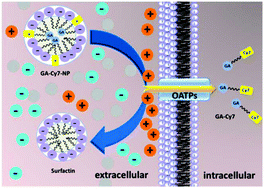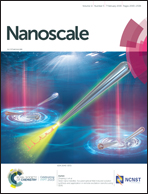A novel “mosaic-type” nanoparticle for selective drug release targeting hypoxic cancer cells†
Abstract
The surface potential of particles is a double-edged sword for nanomedicine. The negative charge can protect nanoparticles from clearance before they reach the tumor tissue; however, it is difficult to phagocytose the negative particles by target cells due to the negative potential of the cytomembrane. Preparing techniques to efficiently release the encapsulated drug from negative nanoparticles into target cells is a formidable challenge facing advanced drug delivery studies. Herein, we have developed a novel “mosaic-type” nanoparticle system (GA-Cy7-NP) for selective drug release targeting hypoxic cancer cells. In this system, hypoxia-targeting near-infrared dye (Cy7) moiety with a positive charge is conjugated to an antitumor agent, namely, gambogic acid (GA). This conjugate could self-assemble into nanoparticles with surfactin in an aqueous solution, where the Cy7 group is embedded in the negatively charged particle surface formed by surfactin. Most remarkably, the “mosaic-type” nanoparticles could selectively release the loaded drug conjugates into hypoxic cancer cells without particle internalization. Using in vitro PC3 cell and xenograft mouse models, we demonstrate that GA-Cy7-NP exhibits enhanced drug distribution in tumor cells and superior antitumor activity as compared to the prototype drug when evaluated in terms of cell proliferation, tumor growth, and angiogenesis assay.



 Please wait while we load your content...
Please wait while we load your content...